Lettered and numbered circular tables lined the 150,000-square-foot New Jersey Convention Center, each one filled with a dozen rabbis and Jewish communal leaders, close to 6,000 people in all. They came together for the annual International Conference of Chabad-Lubavitch Emissaries (Kinus Hashluchim), which brings together Chabad rabbis and lay leaders from all 50 states and 100 countries, from California to Rwanda to Myanmar.
In a year of growing challenges for the Jewish people, with anti-Semitism increasing both domestically and worldwide, including the horrific shooting in April at Chabad of Poway that left one woman dead and three injured, the conference struck a defiant and positive tone, focusing on all the good that has been accomplished and all the work on behalf of the Jewish people yet to come.
The gathering comes as the world marks 25 years since the passing of the Rebbe, Rabbi Menachem M. Schneerson, of righteous memory, who, following his ascension to the leadership of the Chabad movement 70 years ago, began sending emissaries around the world. What started as a handful of brave pioneers has grown into an army of 5,000 couples, rabbis and their wives, who leave home and hearth to serve Jewish communities, or, at times, build them from scratch, in places near and far.
A case in point was Rabbi Chaim Bar Sella of Kigali, Rwanda, who opened the evening by leading the assembled in reading a chapter of Psalms. Bar Sella and his wife, Dina, and their 11-month old son, Schneur Zalman, packed their bags in September and moved to the Central African nation, where together they established Chabad of Rwanda, as well as the country’s first-ever synagogue and Jewish center.
https://www.youtube.com/watch?v=nRLePgxYhMo
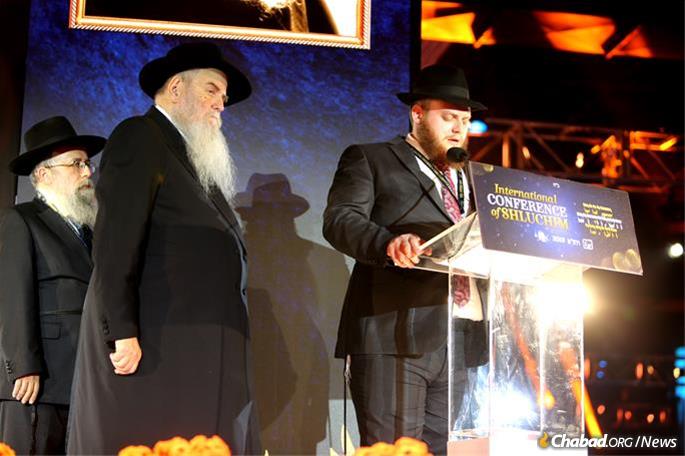
Hurwitz recalled receiving the chilling diagnosis, the news that he would lose his muscles, and then the ability to walk and then, the doctors said, his life. As he left the doctor’s office, he broke into a fit of tears. After composing himself, he walked out of the building and witnessed a man having a seizure, and ran over to help him.
“At that moment, I realized that there is still a lot that I can do,” said the man known by thousands simply as “Rabbi Yitzi,” through his son. “I resolved that no matter what the results of further tests, I was going to remain positive and find a way to make a difference. I couldn’t imagine how high that way of thinking would take me.”
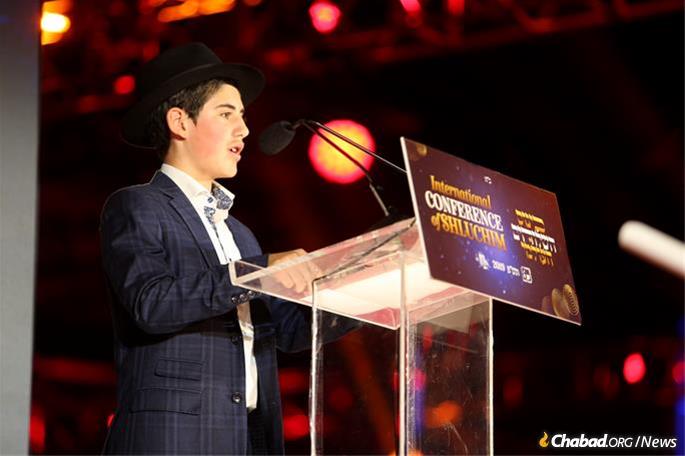
He also acknowledged with appreciation the love, support, friendship, community of the brotherhood of emissaries during his time of need, and their ability to change the world.
“The power, the energy, the love and brotherhood in this room is what makes all of the difference in the world. And it is in every one of you to share with each other and with all of the world.”
Concluding the speech, young Shalom looked into the camera and said “L’chaim” to his bedridden father. His was an emotional standing ovation.
The keynote address was given by U.S. Ambassador to Israel David Friedman, who recalled his first interaction with Chabad back in 1994, when Rabbi Zalman and Chani Wolowik established Chabad of the Five Towns in a little storefront in Woodmere, N.Y. It was, Friedman recalled, within a half-mile radius of probably 15 other synagogues, and he “thought the Chabad House had as much of a chance for success as a store selling ice cubes to Eskimos.”
But soon he formed a relationship with the young Chabad rabbi—one that led to them becoming Torah-study partners for decades. They studied Tanach, beginning with the book of Joshua, which Friedman says not only aided his Judaic studies, but prepared him for his current role as the American ambassador to Israel.
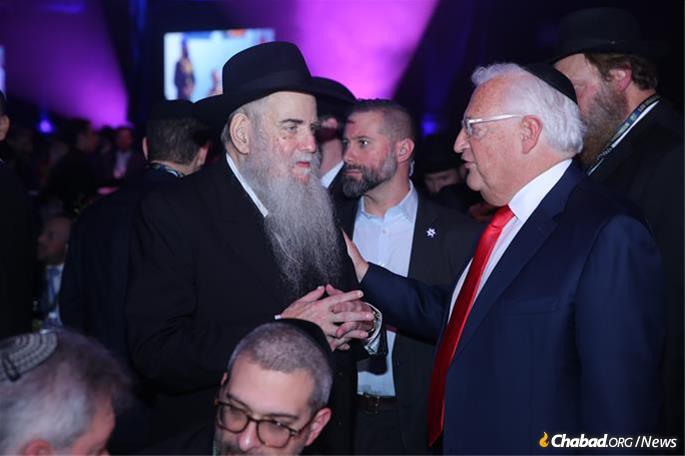
He also recalled how, during the weeks prior to the U.S. decision to move the American embassy to Israel’s eternal capital of Jerusalem and other seminal events, Wolowik took Friedman to the Ohel, the Rebbe’s resting place in Queens, N.Y.
“It’s an oasis of spirituality,” he said. “An opportunity to contemplate what you really need, rather than what you think you want. To ask the Rebbe … to be an advocate for those needs. I’ve never left the Ohel feeling anything but optimism and joy.”
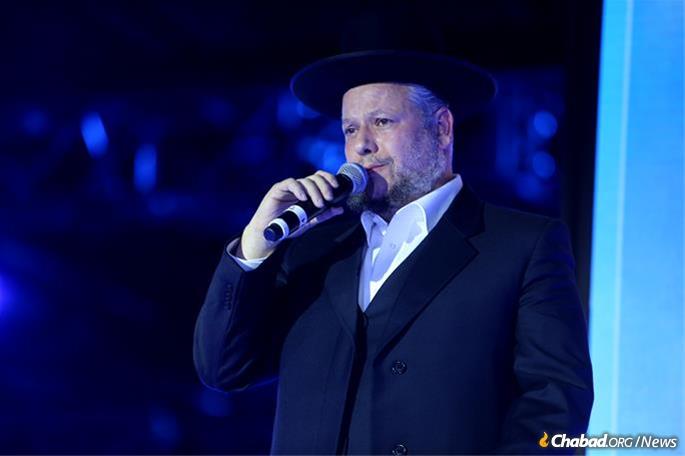
The story, Schochet asserted, has a broader meaning and lesson.
“Because somewhere out there is a Jewish child who is crying; sometimes, the tears are readily discernible; other times—indeed, most often—they’re crying internally, sometimes such that they themselves may be oblivious to their own tears,” declared Schochet. “On the surface, they look strong, forthright, determined, but somewhere deep within, at the core, their souls are crying out.”
This, he explained, was the charge the Rebbe had given to his emissaries around the world, to travel out to all four corners of the world and soothe the crying Jewish child, whether literal or figurative, wherever he or she may be.
In a video presentation that followed, the camera followed the journeys of Rabbi Yehuda Weg, co-director of Chabad of Oklahoma in Tulsa; Rabbi Zeev Stiefel, co-director of Chabad of Piestany, Slovakia; and Rabbi Mendy Chitrik of Chabad of Istanbul in Turkey. As the three-part video unfolded, the audience learned of the Jewish woman of Moroccan descent Weg discovered living on the dusty backroads of Oklahoma, the Slovakian Jew from Kosice who learned he was Jewish from his Holocaust-survivor grandmother on her deathbed and began growing closer to his Jewish roots via Stiefel, and the Turkish family that found out they were Jewish when their grandmother revealed that she, too, was a European Jew who had escaped to Turkey after the Holocaust to start a new life.
“Ask yourself, where would the world be today without the Rebbe’s vision? We just saw evidence of Holocaust survivors, and no one will have shed more tears than them,” said Schochet. “After the ineffable events of 80 years ago, they sought to disappear—in Slovakia, in Turkey—and who can judge them? But then again, who would have gone looking for them? What would have become of them, of their children, of their grandchildren; what would have become of a lost Jewish girl in the backwaters of Oklahoma were it not for the irrational, supra-rational and unconditional devotion of every shliach and shlucha?”
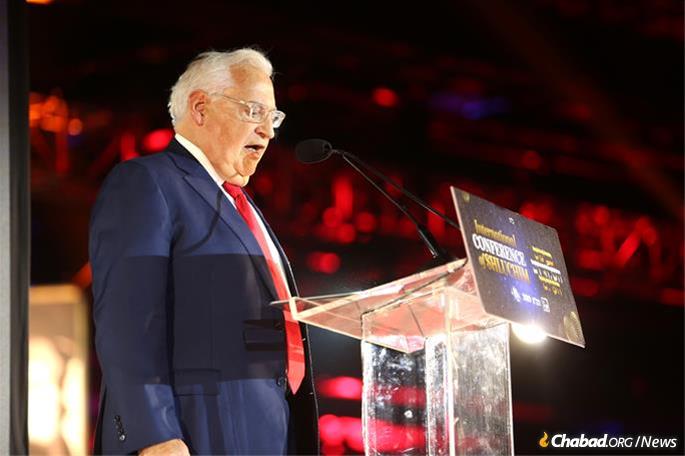
The evening wrapped up with the yearly Roll Call, during which Kotlarsky read out the names of the 100 countries and all 50 states with permanent Chabad emissaries. Announcing a new Chabad center in Myanmar (once called Burma), as well as one in Turks and Caicos, a Carribean island known for its white beaches and blue water but not its Jewish infrastructure, Kotlarsky ended off with his now-trademark “A round of applause for the whole world!” before the room broke out into scheduled, but nonetheless very much spontaneous, dance.
As thousands danced through a maze of converging circles—ID tags and black hats bouncing to the upbeat sounds of Chassidic music—Ron Kramer of S. Monica, Calif., said it was this moment he had come for. Kramer, an entrepreneur with homes in Arizona and the beachside city of S. Monica, met Rabbi Eli Moshe Levitansky, co-director of Chabad of S. Monica College (SMC) nine years ago, when they began a weekly Torah-study session. This is his sixth Kinus, and if anything encapsulates why he keeps coming back, it’s the dancing
“I come to get the essence,” he said. “I come to feel the energy.”
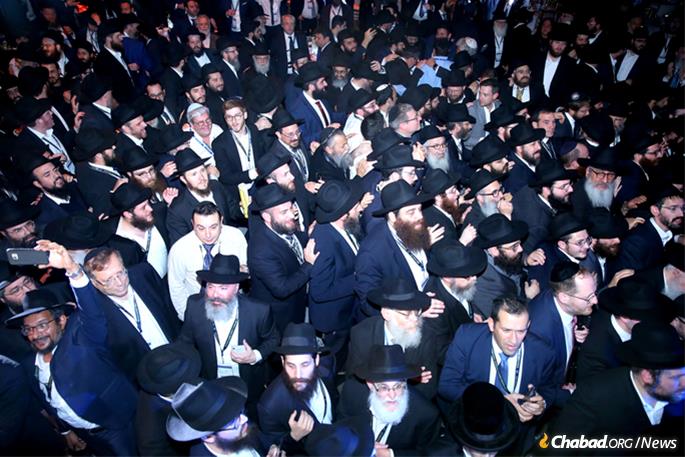





























































































































































































































































13 Responses
you got to admit it chassidim know how to do things
whether satmar or chabad they are go getters who get places
why no comments?
it is humbling to watch , its time we each become a shliach in our home & office to inspire & be mechazek in our avodas hashem – i will begin with making my shabbos seudos more spiritual than a family lunch ( sing some of the printed zemiros , a maaseh and in general to channel it in the right direction . ufaratzta!!
They said the Rebbe’s kapitel Tehillim (#118), out loud, betzibur there, as well as the Rebbetzin’s (#119), based on their custom that a person says the kapitel of the number of the year of their life they are in.
The problem is that that both the Rebbe and the Rebbetzin passed away deacdes ago. So why do they keep adding years to them, and changing their kapitel every year? And they claim that they accept that the Rebbe was niftar, it is just some other mishugoim who don’t? But meanwhile they, the alleged ‘mainstream Lubavitch’ is still acting as if the Rebbe and Rebbetzin are alive.
Who is being fooled here???
Connection to a tzadik or rebbe is soul to soul.
The Jewish soul does not die and continues to progress on high.
Saying the kapitel or connecting in any other way is not “acting as if they are alive”.
When the sixth Lubavitcher Rebbe passed away, did they continue saying his kapitel years afterward and changing it one ahead every year on his birthday? I don’t think so. When the Alter Rebbe passed away, did they continue saying his kapitel fifty years later?
This seems to be a new thing, obviously invented for this last Rebbe, who some people have trouble admitting that he passed away.
Let no one be fooled, let us stop playing games here. The MC at the banquet Reb Kotlarsky should explain exactly what is going on and why they say the specific kapitel they do every year, instead of playing silly games.
Tzadikum bemisusum keruim chayim
The Lubavitcher Rebbe actually addressed this question, and instructed everyone to continue saying the previous Rebbe’s kapitel. You keep alerting us “not to be fooled” but it seems you rely on ignorance to slander lubavitch.
Some things never change…
(*page 496 in Likutei sichos {argument between Rambam and raaved})
Reb lit, are you of the opinion that once someone dies, their neshama and life message are irrelevant and focusing on them is pretending they are alive?
Don’t all Torah jews believe that life has different aspects? We can all agree that someone has passed on, but be alive spiritually and in our minds and hearts?
Do you believe in the eternity of our souls?
Because it is the soul which makes a rebbe special in the first place.
Lit, I am confused by your words. You are constructing a building in mid air, and then complaining why no one is renting it.
You say:
1. It is “their custom” that a person says the kapitel of the number of the year of their life they are in.
2. Your “expertise” on their customs gives you authority to claim that they apply this custom only to a person alive and cease saying the corresponding kapitel upon the person’s demise.
3. Based on these two unsourced points of YOUR understanding of THEIR customs, you point out that they continue to add the next kapitel annually on the Rebbe’s birthday.
4. Applying your astute powers of deduction and supreme intelligence, you conclude that they must consider the Rebbe (a) still alive, and more so, (b) actually aging each year (since if he was alive and not aging, they would continue saying the same kapitel as was said upon his “demise” or histalkus).
5. Thus you conclude your pilpul / bilbul that this is conclusive “proof” of their deceptive actions and trickery because AHA! – they believe he is alive.
Is this your thesis???
I have far greater proof!
I saw many chassidim say “Lchayim” on his Yartzeit, and clearly they were saying L’chayim to him, wishing him long life. In the world of shtus, that is a much better proof.
Now, how many apartments are still for rent in the building you are constructing in mid-air?
Pintele Yid:
1) You cite Likutei Sichos p. 496 but don’t give a cheilek. If you would give the cheilek and a link it would be easier for people to see it.
2) It is known that the seventh Lubavitcher Rebbe claimed that he was a continuation of his shver, the sixth Lubavitcher Rebbe, so it is not such a surprise that he would say such a thing. At that time there was a living successor Rebbe. However, now, since the last Lubavitcher Rebbe passed away over twenty five years ago, there is no living (al pi pashtus hadvorim of what living means) Rebbe.
Also, you did not answer if they continued saying the kapitel of the Alter Rebbe, the founder of Habad-Lubavitch, many years after his passing (as well as other Rebbes, such as Mittele, Tzemach Tzedek, Maharash, Rashab). It seems not, as if the seventh Rebbe had to establish such a practice, evidently it was a new thing.
The point still stands, they are treating it as if the last Rebbe and Rebbetzin are bechayim chayusam, bechayim gashimiyim, lematah measarah tefochim, now, which is not the case.
Lit,
1. It is chelek beis. If you look it up you will see that your inferences and assumptions about this whole issue are in error. The reason the Rebbe said to say the previous Rebbe’s kapitel is as I said in my first comment (and subject to the argument of the Rambam and Raaved) and not as you hypothesize.
Even if the the minhag of saying one’s kapitel was around for ages (I simply don’t know) it was certainly popularized by the previous Rebbe (as with shabbos mevorchim tehillem and the daily portion). Your original outcry was based on the fact that it was invented for our rebbe, about which you are clearly wrong.
2. The notion that lubavitchers treat the rebbe and Rebbetzin as if they are actually alive is ludicrous. You are welcome to interpret things as you like, but I think I and other comments have demonstrated that not only are there answers to your claims, but your claims themselves are based on ignorant and even arrogant assumptions.
(arrogant because you interpret and assume motive and reasoning as if you have properly learned the thousands of seforim of Chabad chasidus and your questions never were addressed. As the rebbe once told someone claiming to be an apikores, “you aren’t an apikores, youre an am Haaretz. An apikores must be learned in what he is rejecting”.
My impression is that you simply see customs that make you uncomfortable, and construe them to mean things they do not in order to dismiss them.)
3. I suggest you research the issue of life in Jewish thought. Life at large, life after death, the life of a tzadik and the life of a tzadik after death. There is much Talmudic precedent for Chabad’s actual belief (which is nothing like what you present it). The issue is nuanced and requires an explanation of terms. You certainly won’t understand it if you decided what it means before learning about it.
I refer you to the above comment from rebbochur. And I can send you a list of sources if you actually want to learn with an open mind and not simply condemn something you don’t even understand.
Perhaps there are bigger issues in the Jewish world than people saying an extra chapter of tehillem.
P.Y. – Do you think Lit is looking for the emes? That he is interested in researching this like a difficult Rambam or sugya and coming to conclusions? No. When a dog howls at the moon is he seeking an understanding of what the moon is and how the howling does not effect the moon? No, the dog barks because it is a hound, and hounds – howl.
Maybe Lit is just looking for negative attention, to stir up things and raise some dust. If so, by responding to him we gave him the joy of his life and were mesameach a yid, boruch Hashem.
This was an awesome conference. Don’t all Torah Jews believe that life has different aspects? We can all agree that someone has passed on, but be alive spiritually and in our minds and hearts?I think I and other comments have demonstrated that not only are there answers to your claims, but your claims themselves are based on ignorant and even arrogant assumptions.